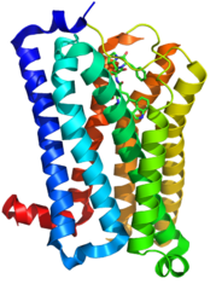 CB1 and CB2 Receptor Genetics
CB1 and CB2 Receptor Genetics The Cannabis Papers: A citizen’s guide to cannabinoids (2011)
By Publius
A Super Bowl of Cannabinoids
In sports as in life, teamwork creates homeostasis. Sure there will be big plays and impressive moves in Sunday’s Super Bowl, yet all fans and players know it’s the little things that count – that create the conditions for that game-winning moment. It’s the same in our bodies as homeostatic processes – teamwork – function without notice or acclaim (even while we sleep). In celebration of game-winning moments, here are four new PubMed articles discussing our CS and homeostatic teamwork: management of neuroinflammatory (brain) disorders, CB1 anti-aversive panic properties, obesity and the therapeutic agents THCV and CBD, and cannabinoids as a tool in modern cancer pharmacotherapy.
Happy CS Super Bowl All!
I. Neuroinflammatory: Cannabinoids as Immunoregulatory and Immunomodulatory
“A growing body of evidence suggests that Cannabis sativa-derived phytocannabinoids, as well as synthetic cannabinoids, are endowed with significant immunoregulatory and anti-inflammatory properties, both in peripheral tissues and in the CNS, through the activation of cannabinoid receptors. In this review, the immunomodulatory effects of cannabinoid signaling on the most relevant brain immune cells will be discussed. In addition, the impact of cannabinoid regulation on the overall integration of the manifold brain immune responses will also be highlighted, along with the implication of these compounds as potential agents for the management of neuroinflammatory disorders.”
Cannabinoid Signaling and Neuroinflammatory Diseases: A Melting pot for the Regulation of Brain Immune Responses.
Chiurchiù V, Leuti A, Maccarrone M.
J Neuroimmune Pharmacol. 2015 Jan 20. [Epub ahead of print]
PMID: 25601726 [PubMed - as supplied by publisher]
Related citations
II. Brain: Panic, Dorsolateral Periaqueductal Grey and CS CB1 Receptors
“Since the cannabinoid CB1 receptor modulates various types of aversive responses, this study tested the hypothesis that enhancement of endocannabinoid signalling in the dorsolateral periaqueductal grey inhibits panic-like reactions in rats. … The present results confirm the anti-aversive property of direct CB1 receptor activation in the dorsolateral periaqueductal grey.”
Role of endocannabinoid signalling in the dorsolateral periaqueductal grey in the modulation of distinct panic-like responses.
Batista LA, Bastos JR, Moreira FA.
J Psychopharmacol. 2015 Jan 19. pii: 0269881114566259. [Epub ahead of print]
PMID: 25601395 [PubMed - as supplied by publisher]
Related citations
III. Obesity: Liver Metabolism, Hepatosteatosis and the Cannabinoids THCV and CBD
“Obesity and associated metabolic syndrome have quickly become a pandemic and a major detriment to human health globally. The presence of non-alcoholic fatty liver disease (NAFLD; hepatosteatosis) in obesity has been linked to the worsening of the metabolic syndrome, including the development of insulin resistance and cardiovascular disease. Currently, there are few options to treat NAFLD, including life style changes and insulin sensitizers. Recent evidence suggests that the cannabinoids Δ9-tetrahydrocannabivarin (THCV) and cannabidiol (CBD) improve insulin sensitivity; we aimed at studying their effects on lipid levels. … Our results suggest that THCV and CBD might be used as new therapeutic agents for the pharmacological treatment of obesity- and metabolic syndrome-related NAFLD/hepatosteatosis.”
Two non-psychoactive cannabinoids reduce intra-cellular lipid levels and inhibit hepatosteatosis.
Silvestri C, Paris D, Martella A, Melck D, Guadagnino I, Cawthorne M, Motta A, Marzo VD.
J Hepatol. 2015 Jan 13. pii: S0168-8278(15)00003-3. doi: 10.1016/j.jhep.2015.01.001. [Epub ahead of print]
PMID: 25595882 [PubMed - as supplied by publisher]
Related citations
IV. Cancer: Cannabinoids and Antimetastatic and Antiangiogenesis
“Regarding the underlying antimetastatic mechanism, several studies revealed cannabinoids to alter the gene expression of cancer cells toward a less-aggressive phenotype and to modulate their secretomic profile. Cannabinoids likewise modulate the release of factors from tumor cells that subsequently suppress the chemoattraction of vessel cells thereby conferring antiangiogenesis. … In addition, beneficial interactions of cannabinoids with currently used chemotherapeutics as well as the influence of cannabinoids on tumor-immune surveillance are addressed. Collectively, the currently available data suggest cannabinoids as a potential tool in modern cancer pharmacotherapy.”
New insights into antimetastatic and antiangiogenic effects of cannabinoids.
Ramer R, Hinz B.
Int Rev Cell Mol Biol. 2015;314:43-116. doi: 10.1016/bs.ircmb.2014.10.005. Epub 2014 Dec 18.
PMID: 25619715 [PubMed - in process]
Related citations
Posted by Bryan W. Brickner






 RSS Feed
RSS Feed
